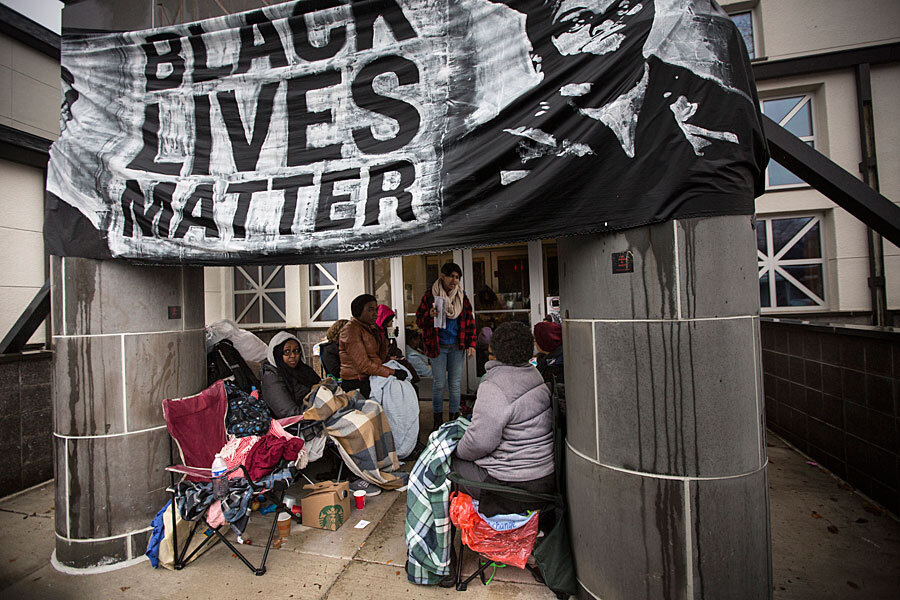Will this jarring incident at Harvard Law School lead to heightened activism?
Loading...
Early Thursday morning, a student at Harvard Law School discovered that the framed photos of faculty on a wall outside a lecture hall had been defaced in what some are calling a hate crime.
At first glance, it’s hard to notice the alteration to the black-and-white portraits. But sure enough, the single piece of black tape across a smattering of faces is soon discernable. All of them are black.
“The portraits of black professors, the ones that bring me and so many other black students feelings of pride and promise, were defaced,” Harvard Law School student Michele Hall wrote Thursday.
“Their faces were slashed through, X-ing them out, marking them as maybe unwanted or maybe unworthy or maybe simply too antithetical to the legacy of white supremacy on which Harvard Law School has been built.”
Harvard University police are now looking into the incident. A spokesman has told the Boston Globe that it’s a an “open and active investigation.”
Law school Dean Martha Minow sent an e-mail to students after finding out about the vandalism.
She said she has planned a meeting with students and staff at noon regarding what happened.
“I am saddened and angered by this act,” she wrote.
On Wednesday, Harvard students and others in the area protested in the streets of Cambridge and Somerville, Massachusetts, in solidarity with the Black Lives Matter movement that has swept over college campuses across the country.
Since it emerged from the streets of Ferguson, Mo. following the fatal police shooting of the unarmed Michael Brown, the social justice movement has gained traction among university students.
Today, on many campuses, the movement is a loose collective of activists who use the hashtag #BlackLivesMatter to organize rallies and demonstrations that promote fairer conditions for students and faculty of color, as well as overall equality for minority people.
“The shift to academia has expanded the movement’s focus beyond raw anger over young men dying at the hands of police,” The Washington Post’s Sandhya Somashekhar reported.
“Campus activists tend to have more nuanced and even symbolic concerns,” she wrote, such as criminal justice reform, diversity in staffing, more multicultural spaces, and curricula that prioritize social and cultural understanding.
In the past few months, Black Lives Matter has gained notable momentum. Last week, black students, athletes, and their allies at the University of Missouri succeeded in calling for the resignation of President Tim Wolfe after what they considered negligent treatment from the university's administration.
At Yale University, following a slew of protests and demands, President Peter Salovey announced Tuesday an array of initiatives and promises aimed towards diversity and understanding, including the creation of a new university center and an increase in the budget for cultural organizations.
At Columbia University, activist group Students Against Mass Incarceration, in conjunction with Black Lives Matter, succeeded this summer in convincing the university to divest from private prisons.
And at Georgetown University in Washington, D.C., a demonstration in solidarity with Yale and Mizzou led to the renaming of two buildings on campus that canonized slave owners.
Despite their progress, some institutions have struggled to meet the demands of student protesters working to promote diversity. And some protests on college campuses have garnered criticism. The Atlantic's Conor Friedersdorf wrote on Nov. 9, after the Yale protests that the new student protest movement on college campuses may reflect a different kind of intolerance:
Watching footage of [a meeting between student protesters and Yale administrator Nicholas A. Christakis], a fundamental disagreement is revealed between professor and undergrads. Christakis believes that he has an obligation to listen to the views of the students, to reflect upon them, and to either respond that he is persuaded or to articulate why he has a different view ... But many of the students believe that his responsibility is to hear their demands for an apology and to issue it. They see anything short of a confession of wrongdoing as unacceptable. In their view, one respects students by validating their subjective feelings.
Thursday's incident not only affirms the precise reasons for inciting protest but also demonstrates the obstacles ahead for young activists.
“This morning at Harvard Law School we woke up to a hate crime. And tomorrow you will wake up to a hate crime on your campus too,” Hall wrote.
But, she continued, “We will march and scream and sit in and walk out and shout our demands and make ourselves heard and tear down these hallways of white supremacy because we belong here, too.”








